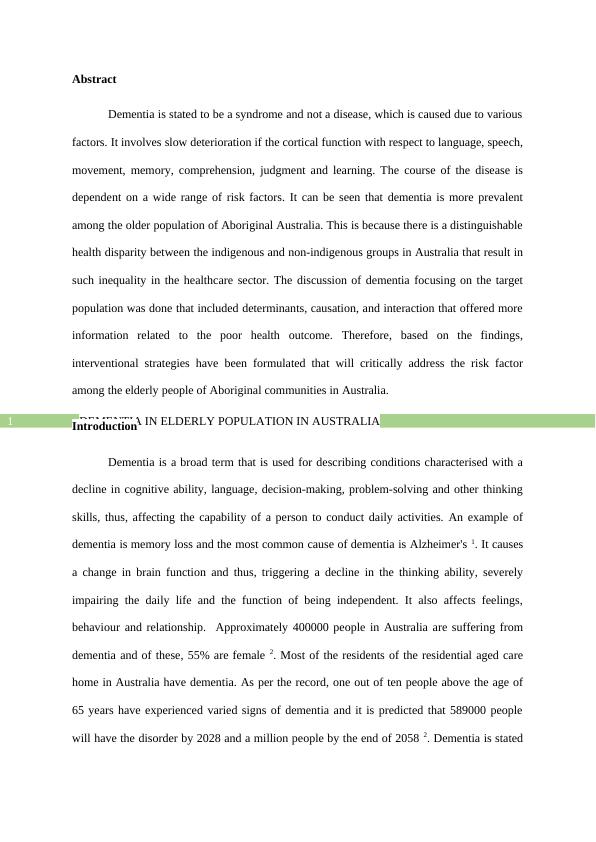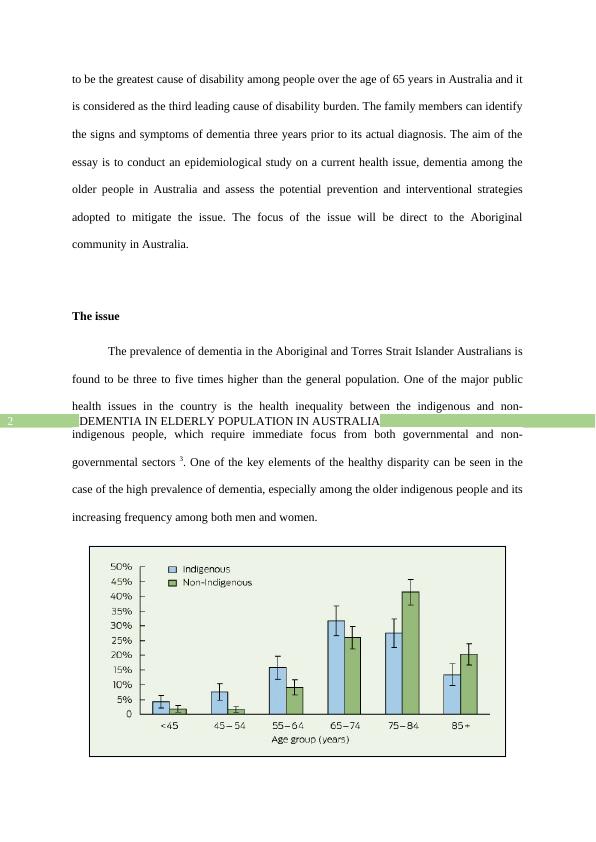Assignment on Dementia in Elderly Population in Australia
Added on 2022-08-30
13 Pages3013 Words17 Views
Running head: DEMENTIA IN ELDERLY POPULATION IN AUSTRALIA
DEMENTIA IN ELDERLY POPULATION IN AUSTRALIA
Name of the Student:
Name of the University:
Author’s Note:
DEMENTIA IN ELDERLY POPULATION IN AUSTRALIA
Name of the Student:
Name of the University:
Author’s Note:

DEMENTIA IN ELDERLY POPULATION IN AUSTRALIA1
Abstract
Dementia is stated to be a syndrome and not a disease, which is caused due to various
factors. It involves slow deterioration if the cortical function with respect to language, speech,
movement, memory, comprehension, judgment and learning. The course of the disease is
dependent on a wide range of risk factors. It can be seen that dementia is more prevalent
among the older population of Aboriginal Australia. This is because there is a distinguishable
health disparity between the indigenous and non-indigenous groups in Australia that result in
such inequality in the healthcare sector. The discussion of dementia focusing on the target
population was done that included determinants, causation, and interaction that offered more
information related to the poor health outcome. Therefore, based on the findings,
interventional strategies have been formulated that will critically address the risk factor
among the elderly people of Aboriginal communities in Australia.
Introduction
Dementia is a broad term that is used for describing conditions characterised with a
decline in cognitive ability, language, decision-making, problem-solving and other thinking
skills, thus, affecting the capability of a person to conduct daily activities. An example of
dementia is memory loss and the most common cause of dementia is Alzheimer's 1. It causes
a change in brain function and thus, triggering a decline in the thinking ability, severely
impairing the daily life and the function of being independent. It also affects feelings,
behaviour and relationship. Approximately 400000 people in Australia are suffering from
dementia and of these, 55% are female 2. Most of the residents of the residential aged care
home in Australia have dementia. As per the record, one out of ten people above the age of
65 years have experienced varied signs of dementia and it is predicted that 589000 people
will have the disorder by 2028 and a million people by the end of 2058 2. Dementia is stated
Abstract
Dementia is stated to be a syndrome and not a disease, which is caused due to various
factors. It involves slow deterioration if the cortical function with respect to language, speech,
movement, memory, comprehension, judgment and learning. The course of the disease is
dependent on a wide range of risk factors. It can be seen that dementia is more prevalent
among the older population of Aboriginal Australia. This is because there is a distinguishable
health disparity between the indigenous and non-indigenous groups in Australia that result in
such inequality in the healthcare sector. The discussion of dementia focusing on the target
population was done that included determinants, causation, and interaction that offered more
information related to the poor health outcome. Therefore, based on the findings,
interventional strategies have been formulated that will critically address the risk factor
among the elderly people of Aboriginal communities in Australia.
Introduction
Dementia is a broad term that is used for describing conditions characterised with a
decline in cognitive ability, language, decision-making, problem-solving and other thinking
skills, thus, affecting the capability of a person to conduct daily activities. An example of
dementia is memory loss and the most common cause of dementia is Alzheimer's 1. It causes
a change in brain function and thus, triggering a decline in the thinking ability, severely
impairing the daily life and the function of being independent. It also affects feelings,
behaviour and relationship. Approximately 400000 people in Australia are suffering from
dementia and of these, 55% are female 2. Most of the residents of the residential aged care
home in Australia have dementia. As per the record, one out of ten people above the age of
65 years have experienced varied signs of dementia and it is predicted that 589000 people
will have the disorder by 2028 and a million people by the end of 2058 2. Dementia is stated

DEMENTIA IN ELDERLY POPULATION IN AUSTRALIA2
to be the greatest cause of disability among people over the age of 65 years in Australia and it
is considered as the third leading cause of disability burden. The family members can identify
the signs and symptoms of dementia three years prior to its actual diagnosis. The aim of the
essay is to conduct an epidemiological study on a current health issue, dementia among the
older people in Australia and assess the potential prevention and interventional strategies
adopted to mitigate the issue. The focus of the issue will be direct to the Aboriginal
community in Australia.
The issue
The prevalence of dementia in the Aboriginal and Torres Strait Islander Australians is
found to be three to five times higher than the general population. One of the major public
health issues in the country is the health inequality between the indigenous and non-
indigenous people, which require immediate focus from both governmental and non-
governmental sectors 3. One of the key elements of the healthy disparity can be seen in the
case of the high prevalence of dementia, especially among the older indigenous people and its
increasing frequency among both men and women.
to be the greatest cause of disability among people over the age of 65 years in Australia and it
is considered as the third leading cause of disability burden. The family members can identify
the signs and symptoms of dementia three years prior to its actual diagnosis. The aim of the
essay is to conduct an epidemiological study on a current health issue, dementia among the
older people in Australia and assess the potential prevention and interventional strategies
adopted to mitigate the issue. The focus of the issue will be direct to the Aboriginal
community in Australia.
The issue
The prevalence of dementia in the Aboriginal and Torres Strait Islander Australians is
found to be three to five times higher than the general population. One of the major public
health issues in the country is the health inequality between the indigenous and non-
indigenous people, which require immediate focus from both governmental and non-
governmental sectors 3. One of the key elements of the healthy disparity can be seen in the
case of the high prevalence of dementia, especially among the older indigenous people and its
increasing frequency among both men and women.

DEMENTIA IN ELDERLY POPULATION IN AUSTRALIA3
Figure 1: Prevalence of dementia among indigenous and non-indigenous people in
Australia
From figure 1, it can be clearly noted that the frequency of dementia is negligence
among t below the age of 45 years and significantly increase above the age of 65 years in
both the population. The reason because of which, the prevalence of dementia is higher in the
age group 75 to 84 years and above 85 years is due to the poor healthcare service of the
indigenous people 4. The life expectancy of the indigenous people is found to be less as
compared to the non-indigenous population in Australia due to the predominant
discrimination in the health-related aspect.
Determinants
The global burden of dementia is increasing all over the world in a dramatic manner
and it particularly concerns Aboriginal Australians because of the high prevalence rate. Most
of the Australian population suffers from Alzheimer’s, which is stated to be a common type
of dementia; however, treatment is still unknown 5. The researches and evidence state that the
identification of the underlying risk factors has been made of the epidemic that can be
modified in order to treat the patient. The identifiable global risk factors are low level of
education, depression, smoking, physical inactivity, obesity, hypertension and diabetes.
According to a systematic review, it was noted that the predominant risk factors among all
types of dementia indicate that there is a strong link between depression and type 2 diabetes
mellitus. In addition to this, two newly observed risk factors that are associated with the
disorder is social contact and misuse of benzodiazepine 6.
Figure 1: Prevalence of dementia among indigenous and non-indigenous people in
Australia
From figure 1, it can be clearly noted that the frequency of dementia is negligence
among t below the age of 45 years and significantly increase above the age of 65 years in
both the population. The reason because of which, the prevalence of dementia is higher in the
age group 75 to 84 years and above 85 years is due to the poor healthcare service of the
indigenous people 4. The life expectancy of the indigenous people is found to be less as
compared to the non-indigenous population in Australia due to the predominant
discrimination in the health-related aspect.
Determinants
The global burden of dementia is increasing all over the world in a dramatic manner
and it particularly concerns Aboriginal Australians because of the high prevalence rate. Most
of the Australian population suffers from Alzheimer’s, which is stated to be a common type
of dementia; however, treatment is still unknown 5. The researches and evidence state that the
identification of the underlying risk factors has been made of the epidemic that can be
modified in order to treat the patient. The identifiable global risk factors are low level of
education, depression, smoking, physical inactivity, obesity, hypertension and diabetes.
According to a systematic review, it was noted that the predominant risk factors among all
types of dementia indicate that there is a strong link between depression and type 2 diabetes
mellitus. In addition to this, two newly observed risk factors that are associated with the
disorder is social contact and misuse of benzodiazepine 6.

End of preview
Want to access all the pages? Upload your documents or become a member.
Related Documents
Australian Government Department of Healthlg...
|10
|2403
|20
Health Care Delivery Methods in Dementia and Impact of Povertylg...
|11
|2841
|165
Approach to Dementia Care Practice Improvementlg...
|5
|1026
|23
Dementia and Aging: Types of Health Delivery, Impacts of Poverty, and Discrimination in Healthcarelg...
|11
|3215
|351
Dementia Health Issue in Australialg...
|10
|2818
|346
Health and social care Assignment Samplelg...
|4
|707
|23